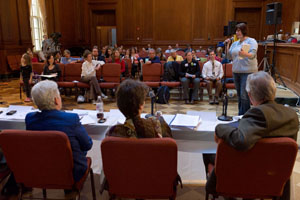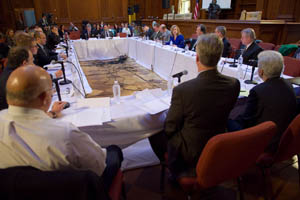Developing Clean Air Programs Through Dialogue
Consulting with stakeholders, as well as government partners, is an important part of EPA's efforts to implement the Act.
Working with Stakeholders to Design and Implement Clean Air Programs
EPA has learned from experience that working closely with stakeholders and government partners can lead to better programs that are more effective and efficient, and win broader support. Dialogue and partnerships are an important part of EPA's efforts to reduce pollution under the Clean Air Act through regulatory programs and voluntary partnership programs.
For regulatory programs, EPA often has discussions early in the rulemaking process with government partners (federal, state, local and tribal) and with interested parties such as affected industries, environmental groups, and communities. After a rule is complete, EPA works with government partners and stakeholders to achieve effective implementation.
Over the years, EPA has used both formal and informal processes for engaging stakeholders. For example, soon after the 1990 amendments, formal regulatory negotiations produced agreements on proposed rules to prevent toxic emissions from equipment leaks, set requirements for cleaner “reformulated” and “oxygenated” gasolines, and cut toxic emissions from steel industry coke ovens. Informal talks and consultation with advisory committees produced agreement on rules that controls acid rain and phase out chlorofluorocarbons, which deplete the stratospheric ozone layer. More recently, EPA held hundreds of meetings with stakeholders to help us develop the Clean Power Plan.
Today, EPA continues to use informal engagement processes to develop proposals that reflect the expertise and concerns of affected industries, citizen groups, and government partners, as well as to achieve effective program implementation.
EPA also works closely with partners in government, industry and the public through voluntary partnership programs under the Clean Air Act. Through these programs, EPA helps businesses, the public and governments take actions that reduce emissions of greenhouse gases and conventional air pollutants, and protect people from exposure to pollution-caused harm. Many of these programs have additional benefits such as improving energy efficiency, reducing oil imports, and saving consumers money.
Seeking Guidance from Diverse Stakeholders and Experts
EPA regularly seeks advice from a Clean Air Act Advisory Committee composed of diverse stakeholders and experts. This standing advisory committee includes members from industry, environmental and community groups, state, local and tribal governments, and academia. The committee, established in 1990, advises the Agency on clean air policy, economic, and enforcement issues. EPA continues to meet regularly with the committee to obtain advice on clean air issues facing the agency.
Clean Air Act Advisory Committee web page


